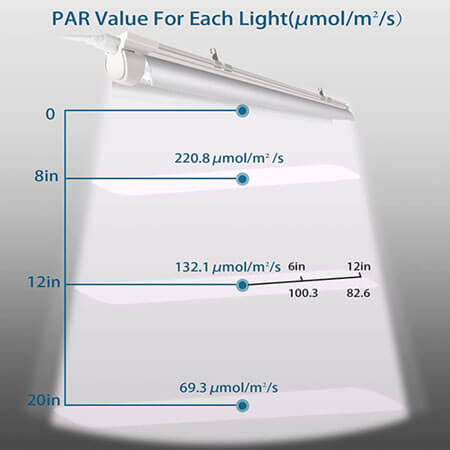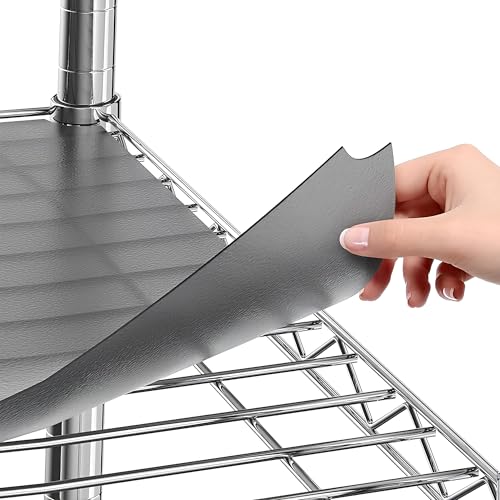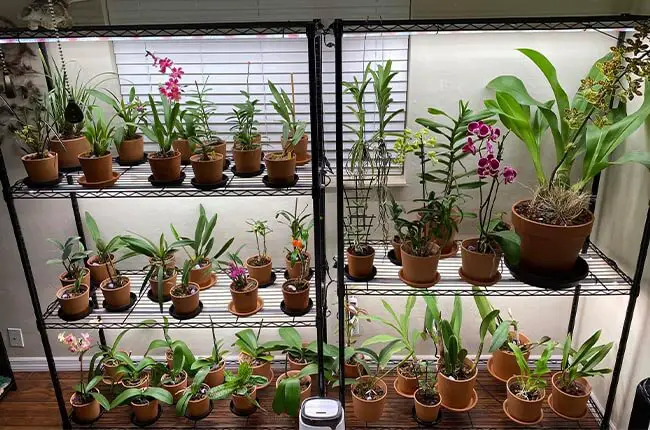Orchids make perfect indoor plants with their low lighting requirement. When given the right artificial lighting, orchids can thrive and bloom indoors in a dark corner or in a room dedicated to growing orchids.
To choose the best grow light for orchids, we need to consider the light intensity in watts, the light spectrum emitted, and other factors.
In this article, we will review the best tabletop grow light for only a few plants in a small space, floor light for tall plants, and shelf grow light for a large space.
Quick Summary
Grow Light | Features |
Table top grow light (Gooing Top) | Pros: for small space Cons: only comes with two lamps (for a few small pots) |
Floor light (Bseah) | Pros: For tall plants and various pots Cons: take up floor space |
Grow light for individual plants (LORDEM) | Pros: can be inserted to any pot Cons: |
Grow light for shelves (Barrina T8) | Pros: full-spectrum |
How to select grow light for orchids?
When selecting a good grow light, there are several factors to consider.
A grow light for orchids must:
- emit a full spectrum of light (PAR) for photosynthesis
- have the right wattage so that the light intensity is not too weak or too strong for orchids. For grow light on shelves, the best is to have 40-50 watts of light per shelf. And it is better to have two 25-watt LEDs instead of one 50-watt LEDs per shelf in order to have a larger surface area of the shelf reached by the same light intensity.
- have the right height: the light intensity of artificial lights can be controlled by varying the distance between the bulb and the foliage. For orchids, LED lights with 40 to 50 watts are best placed at a distance of 4 to 12 inches (10 – 30 cm) away from the foliage, depending on the light requirement of the orchid.
Other features that are good to have:
- The light should appear white or warm white visually, instead of pink as it can make us dizzy and is not aesthetically pleasing
- Longevity: It is important that the lights can last for many seasons, especially since they will be used 12-14 hours a day, year-round, meaning up to 5110 hours per year. Also, they degrade after a few years.
- Waterproof: This is especially important for grow lights on shelves as water can overflow from an upper shelf onto the lights on the lower shelf
- Does not produce heat. When flower spikes touch the lights, they do not get burnt.
- Easy to install
- Light-weighted and not too bulky
- For shelf lights, they can daisy chain or connect various LED lights together to light up a wider space
- Reasonably priced
Best grow light for indoor plants
1. Table top grow light (GooingTop)

This is a grow light with a strong clamp that can be attached to a table or desk.
It comes with LED light on 2 flexible goosenecks, with full spectrum light and adjustable brightness.
It also comes with a timer that can switch itself on and off for a period of 4/8/12 hours every day.
It is perfect for a small countertop space. However, that would mean that it can cover a small space for only two to three small pots.
2. Floor light for tall plants (Bseah)

This grow light features LED on 6 long flexible goosenecks on a sturdy metal tripod stand.
The tripod is adjustable to 31.5 to 60 inches (80 – 152 cm) tall, accommodating houseplants with different heights and sizes.
It offers a full spectrum in white or warm yellow light and is dimmable to offer different brightness levels suitable for the photosynthesis needs of plants from seed germination to flower blooming.
It also has a timer that can switch itself on and off for different periods (4/8/12 hours) every day.
It is one of the most popular grow lights and receives excellent ratings from customers.
It is good value for tall plants and can cover a larger area with various pots. However, it can take up floor space.
3. Grow light for individual plants (Lordem)

This grow light is a halo lamp on a pole with an adjustable length.
You can insert it easily into any pot and adjust the height from 7.8 inches (20 cm) up to 26 inches (66 cm) and also the angle of the light. It is perfect for small indoor plants.
It has a timer with 3 different time settings (4/8/12 hours) that turns itself on and off automatically. It has four adjustable brightness levels that can provide the right amount of light required by different plants. It has a lifetime of 50,000 hours.
It is perfect for office or small space with only 1 or 2 plants as it can be inserted to any pot.
However, it can only cover one small houseplant at a time.
4. Shelf grow light (Barrina T8)
Barrina Grow Lights offer the best-value grow light for growing orchids. You will have 6 lights which are perfect for a stand with 3 shelves (i.e. 2 lights per shelf).

Their T8 model (T8 as in tube-shaped light with one inch or 2.54 cm in diameter) offers the most suitable light intensity for orchids.
The light intensity readings shown in the specs were measured in a testing enclosure which reflects light. In an open growing environment, as it is often the case in real life, the light intensity thus needs to be discounted by 20-40%.

The best light intensity for low-light orchids (e.g. Phalaenopsis, Jewel orchids), which is 100 umol/m2/s, can be achieved by placing two of these Barrina T8 lights at a distance of 12 inches from the foliage of the orchids. They will receive an intensity of light of around (132 x 2) umol/m2/s x 40% = 105.6 umol/m2/s
The optimal light intensity for high-light orchids (e.g. Cattleyas, Vandas), which is around 400-500 umol/m2/s, can be achieved by placing two of these Barrina T8 lights at a distance of 8 inches or even 6 inches from the foliage. At 8 inches of distance, they will receive an intensity of around (220.8 x 2) umol/m2/s x 40% = 176.7 umol/m2/s. A shorter distance of 6 inches would probably be more optimal for high-light orchids.
The Barrina lights, however, do have two downsides:
(1) the light gives off a slight pink hue visually although it does not affect plant growth,
(2) the lights are only 80% waterproof that can only withstand a light mist but not water overflowing from a higher shelf to the lights on a lower shelf. But, this can be mitigated by using shelf liners before placing the pots on top.
Here is a summary of the features of the Barrina grow lights
Features | Barrina T8 Grow light |
Full spectrum | Provides full-spectrum light |
Light intensity 100-500 umol/m2/s | The light intensity depends on the distance between the foliage and the light. For two lights per shelf: 12 inches for Phalaenopsis 8 inches for medium-light orchids 6 inches for high-light orchids (e.g. Cattleyas, Vandas) |
Low energy consumption | Each light consumes only 24 watts |
Light color | The light comes off as warm white, with a very slight pink hue |
Longevity | Proven to at least last for 3 years |
Waterproof | 80% waterproof (there are lenses covering the diodes that can keep minor mist from the electrical contacts) |
Do not produce heat | They produce very little heat |
Easy to install | Easy installation with included double-sided tape, clips and cable ties. |
Light-weighted | Yes |
Daisy chainable | The LEDs available in lengths of 24 inches and can link up to 16 lights in a series to one power source |
Others | Each grow light has an on/off switch that can be controlled separately |
How to set up grow lights on shelves?
To set up your orchid growing shelf, you will need:
The shelf measures 36 x 14 x 57.75 inches (L x W x H). It allows you to mount LEDs on three levels, each of about 18 inches in height. Three levels per shelf are good so that you can group your orchids in three groups with high, medium, low light intensity requirements.

The shelf features:
- an industrial steel frame, assembled with no tools necessary
- With levels of adjustable height
- Each level can hold 88 pounds
- Bonus: the wheels make it easy to move around a heavy shelf with plants
2. Shelf Liners

- Prevents drainage water from falling on the LED lights on the shelves below
- Measures 36 x 14 inches (perfect fit for our shelves), also available in other sizes
3. Zip ties
You need four zip ties per level to mount two LEDs on each level. By tightening the loop of the zip ties, you can adjust the height of the LEDs to be further away from the orchids as they grow in height.
4. LED lights
To achieve different light intensities as required by different orchid species, simply vary the distance between the plant and the light. For
- Phalaenopsis 13-14″ between the canopy to the bottom of the LEDs
- Paphiopedilum 12-13″ between the canopy to the bottom of the LEDs
- Cattleyas, Oncidium 7-9″ between the canopy to the bottom of the LEDs
- Vandas 3″ between the canopy to the bottom of the LEDs
5. Jumper power cords
Jumper cords are used to connect the LEDs from one level to the next and to one power source.
6. Power source
One power source is needed per shelf
7. Timer or Smart plug
Connect the power source to a timer or a smart plug so that you can set it to turn on for 14 hours a day and increase or decrease it according to seasonal needs.
Jeff Young from The Orchid Hobbyist explains how to mount the LEDs to a shelf.
Light spectrum and plant growth
Plants require a full spectrum of light, like natural sunlight, for photosynthesis and blooming. The optimal spectrum for a plant’s photosynthetic needs is between 400 nm (blue) and 700 nm (red) of wavelength, a region called Photosynthetic Active Radiation (PAR).
Plants need blue light for vegetative growth, red light for budding and blooming, as well as other wavelengths of light in-between such as green light.
Too much red or deficiency in blue light would result in hyper-extended petioles and slowed growth. Too much blue light would result in plants with bleached or discolored leaves.
We cannot use our naked eyes to tell whether the light emitted is in full spectrum. This is because our eyes are unable to detect wavelengths such as blue light. So, desk lamps used for reading may resemble the warm white color of sunlight for the human eye but may actually lack blue and red lights as the human eyes cannot detect them. To measure how much light the plant can receive, you will need a PAR meter.

Are all LED lights good for plants indoors?
LED lights are the best type of artificial light for growing plants indoors for having a full spectrum of light, resembling natural sunlight, for photosynthesis. Another benefit of using LED lights is that they don’t produce heat so the orchids will not suffer from heat stress. Also, LED lights consume less electricity, thus lower running costs and are brighter, and do not contain mercury, unlike fluorescents.
However, not all LED lights, e.g. LED reading lamps, can be used for growing plants. Most of the LEDs, especially those not for growing plants, are produced to only emit the green or middle part of the spectrum with little blues or reds as our eyes can see this part of the spectrum better. You can therefore not use an LED reading lamp for growing plants.
Also, due to a lack of regulations and a massive influx of LED lights on the market, many LEDs falsely claim to produce a “wide spectrum” but are in fact deficient in the light spectra, resulting in elongated petioles and lagging growth.
Therefore, for growing plants, we should carefully choose LED lights that are specifically designed for growing plants.
Is artificial light good for orchids?
Growing under artificial light is an effective solution for households where natural lighting is not available indoors. Using artificial lights, a north-facing window (for the northern hemisphere), a dark corner or even a spare room can be set up for growing orchids.
Using fluorescent and LED lights, many people have successfully grown houseplants, bloomed orchids, and over-winterized fruits and vegetables indoors.
Some commercial growers adjust the light intensity and temperature in the growing environment so that their orchids can bloom at a certain time, before putting them out to the market for sale.
Related: Multiple Flower Spikes On Your Orchid? (7 Tips & Tricks)
Conclusion
To find the best grow light for orchids, the most important factor to consider is that it must emit a full spectrum of light and the right intensity. Other factors to consider are whether it is waterproof, lightweight, daisy-chainable, easy to set up, cheap, lasts long, and consumes little energy.
To learn more about how to measure the light intensity of your grow light, check out our article on PAR meters.
Related
Top 8 PAR Light Meters for Orchids
How Much Light Do Orchids Need? (With Light Chart)
- Top 6 Drip Irrigation Systems for Raised Beds (2025) - January 31, 2025
- Top 10 Orchid Fertilizers: A Comprehensive Review (2025) - January 16, 2025
- Top 6 Slow-Release Fertilizers for Houseplants & Veggies (2025) - January 15, 2025





